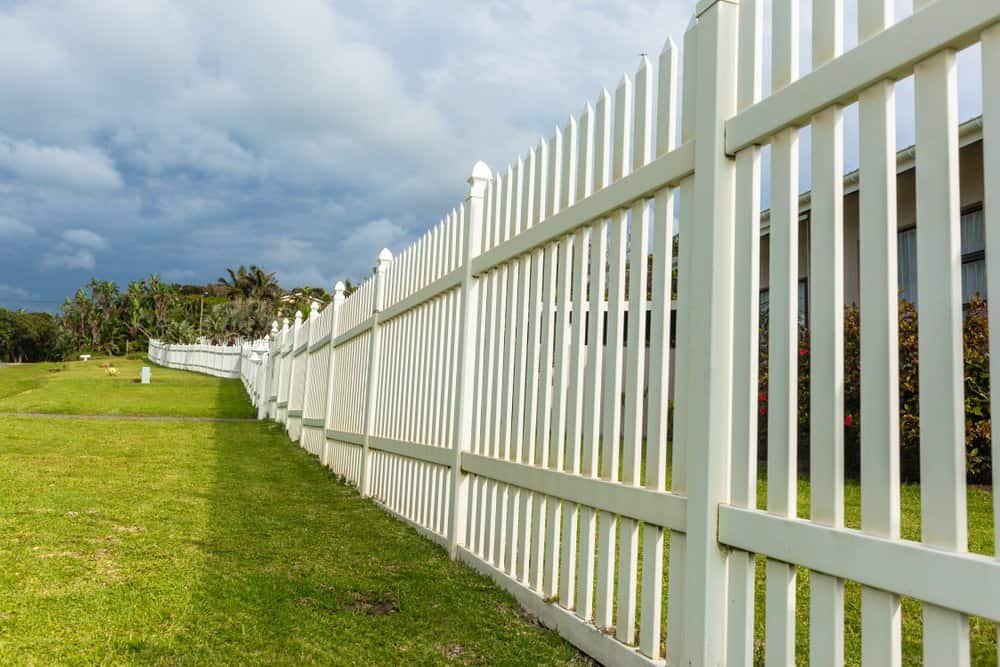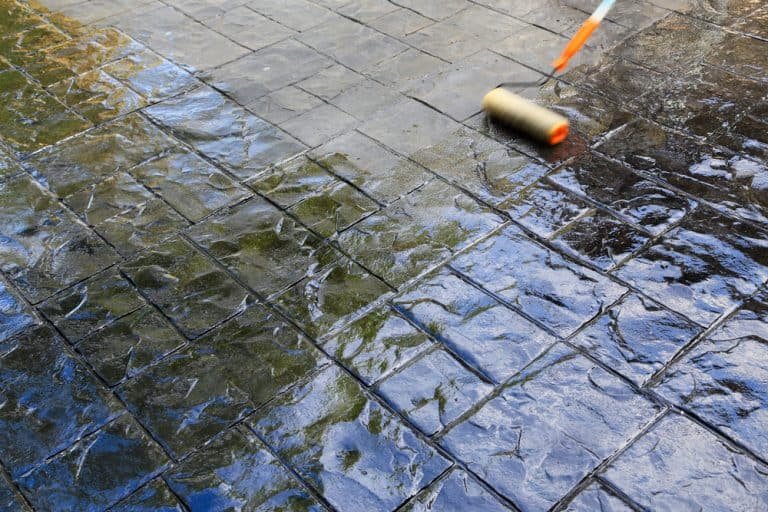How to Clean a PVC Fence in Your Backyard

PVC or vinyl fence is a great choice if you’re looking for lightweight, weather-resistant, and easy to install fencing. Just like any other fencing, it will get dirty. Dirt, mud, algae, and mildew can all ruin the look of PVC fencing, but one of the best features is that it can look brand new after a thorough cleaning.
Many of us choose a PVC fence for its longevity and durability. To keep one looking its best for years to come, check out our list of what to use and how to get it done.

Table of Contents
Spray Down a PVC Fence with a Garden Hose
Sometimes spraying with a hose may be all you need to get your fence fresh and shining again. Since it’s the easiest method and requires the least elbow grease, start with the hose first!
Give the fencing a good spray down, moving back and forth from the top down. Using a high-powered nozzle can make the process easier. Give it a look over to see if there are spots the hose didn’t remove. If there is more to be done, any of the steps below can take care of that.
Use a Magic Eraser
Looking for a basic approach to those stubborn spots? A Mr. Clean Magic Eraser can do the trick.
- Spray down the fence to get it wet and to wash away loose dirt.
- Wet the Magic Eraser thoroughly.
- Start scrubbing the fence; your best bet is from the top down.
- Rinse off the eraser when it gets dirty or remove the dirty parts.
- Give it another spray down to see how you did.
You can repeat this as often as it takes to get at the more resistant spots, like pesky grass stains.
Using Dish Soap and a Non-abrasive Sponge
If you don’t want to use harsh chemicals to clean your fence, but you need more power, dish soap can be a great alternative, particularly Dawn. Make sure you use a non-abrasive sponge or rag as the fence can be easily damaged and scratched.
- Spray down the fence before starting
- Add half a cup of dish soap to a gallon of water.
- Mix it up well.
- Wet your sponge or rag with the solution.
- Get to work on that fence.
When you are finished, spray down the fencing really well to clean off any soap.
Using Vinegar for a New Looking Fence
A stronger and more environmentally friendly approach is using vinegar to clean the fence. Vinegar will kill mold and mildew effectively without any harsh chemicals. Vinegar is often overlooked when thinking of cleaning products, but it packs a punch. Also, it can help give the fence a brand-new look.
- Spray down with a hose to remove surface dirt.
- Depending on how strong you want your solution, add ½ a cup to 2 cups of vinegar to a gallon of water.
- Use and rag or sponge and wipe down the fence.
- Spray off any leftover vinegar.
While any vinegar will do, your best (and least expensive) option for cleaning vinegar is always white distilled vinegar.
Use Mineral Spirits on Tough Fence Stains
Another option is mineral spirits or paint thinner. Some people swear by them due to the fact they can remove tough grease and tire marks. It is a cheap option if you happen to have some lying around in the garage.
- Make sure you use eye and hand protection as mineral spirits can cause mild to severe irritation.
- Use a rag or towel to rub the spirits on the stains.
- For extra tough stains, hold the spirits on the stain for about 30 seconds.
- Be sure to power wash after cleaning. You don’t want any spirits lingering behind.
Note: because mineral spirits can be quite strong, do a patch test first in an inconspicuous area. Make sure the spirits don’t damage the surface of the fencing before you go all-in.
Buying a Ready to Use Fence Cleaner
There are countless cleaners and detergents that you can pick up at your local Home Depot or Lowes. They all get the job done as well. Just be careful when choosing cleaners. Anything with acetone can damage the fence, so be sure to double-check the ingredients. There are even no scrub cleaners out there that many people have success with.
You may or may not need to spray down the fence first, depending on the cleaner you select, but it almost always helps. There are cleaners you need to mix, Ones that attach to your hose, and ones with their own sprayer. Use the cleaner according to the instructions provided.
Using a Power Washer for Extra Dirty Fences
Okay, so nothing else has worked. Let’s bring in the big guns. You can use a power washer to get rid of those pesky stains. You can also use a detergent with the power washer, so the stains don’t stand a chance.
Always use caution when operating a power washer; they can be dangerous if operated improperly, and they can damage the surface of your fence if the PSI is too high.
How Much PSI Is Too Much for PVC Fencing?
Always do a patch test with a power washer to determine the right pressure for the surface. If you are renting a washer, let the shop know what you are using it for, so you know what setting to use. In general, you probably want to be around 1,000-1,500 PSI for light-duty jobs and between 2,000-3,000 PSI for heavier jobs.
The other factor that is works in tandem with PSI is your distance from the fence. Don’t get too close. Stand as far away as you can while still getting results. Any closer than three feet is usually too close.
Use Bleach with Caution on a PVC Fence
Bleach can work well for cleaning algae, mildew, and stubborn stains. Make sure you exercise caution when using bleach. It must be diluted in order to avoid damaging the fence.
- Make sure you are using rubber gloves and eye protection.
- Dilute by adding one cup of bleach into one gallon of water.
- Ensure the bleach is well mixed into the water.
- Use a rag or sponge to clean the fence.
- Spray down again with the hose to remove any traces of bleach.
Remember, this is just for white fences. Using bleach on a non-white fence can cause white stains unless you dilute it well enough. If you are going to try bleach on a PVC that is anything but white, definitely do a patch test.
Regular Maintenance Keeps a PVC Fence Clean
Cleaning your PVC fencing more often can make a world of difference. You are less likely to have trouble with tough stains and mildew. Here are steps to introduce to your regular lawn care routine to help keep that fence in great shape:
- Give the fence a quick hose down once a week to help stop staining.
- Cleaning with vinegar can help hinder the growth of mold and mildew
- Hose down fence after doing yard work. (Try to keep grass clippings away, too!)
- Treat the fence with a mold and mildew protectant as a preventative.
Your PVC fence is meant to last a long time. And like anything else, if you care for them properly, they’ll last even longer.
Painting Over Uncleanable Stains on a PVC Fence
If nothing else works, you can always repaint your fence. Believe it or not, you can paint PVC. You just need to use the correct paint. Make certain you are using a paint that will adhere to the non-porous surface. Acrylic exterior paints usually are what you need, but always check with your fence manufacturer and paint counter expert before deciding what to purchase.
The steps for painting a PVC fence are pretty easy. No need to for all that laborious sanding needed on a wooden fence!
Before getting started, make sure the fencing is free of mold, mildew, and any other dirt. Then:
- Clean. Spray it down with a hose and use soap, if needed.
- Dry. Ensure the fence is COMPLETELY dry before starting any painting or priming
- Prime. Use primer as your first coat – choose one that resists mold and mildew.
- Let the primer cure. Make sure the primer is dry before painting, best practice is to allow a day for drying.
- Paint. Keep an eye out for any drip marks before they dry.
- Seal. If you feel the need, you can add a sealant to the fence for a little added protection
If your fence is large, you may want to invest in a paint sprayer. Never used one on a fence before? Check out a video or two to get an idea of what supplies you’ll need and what technique to use, whatever kind of fencing you are painting.
Fixing Damaged PVC Fence Parts
So, the unthinkable happened, you damaged the fence. Well, luckily, it’s not the end of the world. There are ways to repair PVC fencing, and not all will break the bank.
Vinyl Repair Kit for Holes
If you found a hole while cleaning the fence, you can patch it right up with a vinyl repair kit.

You can also use spray foam insulation to fill the hole and auto body filler to cover the hole up after filling. You can find the process here.
Replacement Parts
If you feel it’s too much work to fix or just plain unrepairable, you can always order replacement parts from the manufacturer. If you bought your fence from a hardware store, check back with them to see what replacement parts they carry.
PVC Fence Cement
PVC Cement can be helpful if you have pieces that have become unattached or won’t stay in place, especially those post caps! You can find it at Home Depot or any hardware store. Here is what to look for.
Conclusion
While any fence will need regular maintenance, PVC fencing can be easy to clean and maintain with the proper knowledge and tools. No matter how you choose to keep your fence looking amazing, you can rest assured that it will hold up for years to come.






